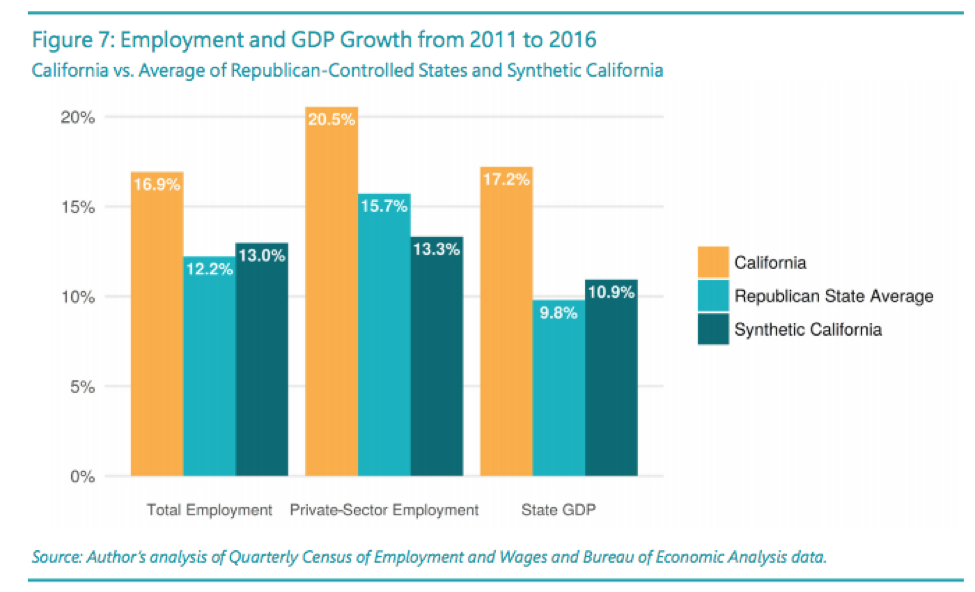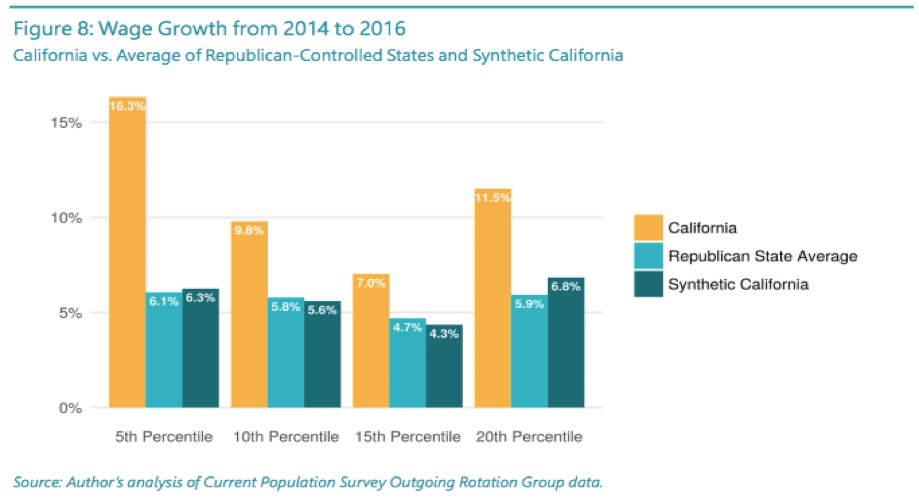California’s reputation as a model climate leader is well-deserved. The state is home to the 4th largest cap-and-trade program in the world, a stringent Renewable Portfolio Standard (RPS), a low-carbon fuel standards, and just recently committed to 100 percent carbon free electricity by 2045. The combination of these policies has drawn praise from climate activists, who view California as a symbol of environmental stewardship. However, these rigorous policies have had their critics, even my colleague Ed Dolan, for their avoidance of more efficient policies and embrace of command-and-control interventions. Breaking down what the costs of benefits of the state’s climate portfolio and comparing them to alternatives is a complicated task.
William McGurn’s recent Wall Street Journal article attributes much of the hardship and struggles of the state’s declining middle class to its climate policies. He claims that California’s green agenda “chokes off economic growth and has been imposed more as a theological imperative” than the result of careful policy design and argues that its policies unfairly burden the state’s poor. That case is exemplified by a recent lawsuit against the California Air Resources Board, brought on by a coalition of 200 prominent civil-rights leaders who argue that the state’s greenhouse gas policies have disproportionately impacted Latinos and African-Americans.
As we consider national policies, it is worth taking a look at how California’s model has performed and whether it is truly leading to economic stagnation. Despite the real perils of being poor or middle class in California, McGurn’s assertion that California’s climate policies are the source of economic malaise is a gross oversimplification.
The Impacts of California’s Policy Model
McGurn cites an article by Joel Kotkin and Marshall Toplansky that depicts California as a feudal society, being characterized by an ultra-rich and rising poverty levels. They point to the fact that over 8 million Californians live below the poverty level, with 77 of the country’s 297 most “economically challenged” cities found in the state. According to America’s Health Rankings, California’s gini coefficient, a measure for income inequality, is one of the worst in the nation, although it has roughly mirrored the gini coefficient of the U.S. as a whole for the last 30 years. The state of the middle-class in California has also declined in recent years. Since 1970, the share of Californians living in the middle-class fell from 60 percent to just over half the population.
Although the overall poverty rate in California (adjusted for cost of living) is one of the highest in the country, we do not really have evidence that the state’s climate policies are to blame. In fact, in a direct comparison against states without comprehensive climate programs California looks golden.
A study by Ian Perry, a researcher at UC Berkeley’s Labor Center, examined the effect of the “California Policy Model” (CPM), a set of 51 policy measures addressing environmental concerns, as well of a host of other public policy issues, on jobs and the economy between 2011-2016. The report compares California’s economic performance to states with Republican-led governments (a proxy for no serious climate action over that period), as well as a synthetic California, whose economic performance after 2011 was estimated as if California had climate policies similar to those Republican-led states.
Over the period in question, California enacted its cap-and-trade program and increased its renewable energy production. Critics have argued that this would damage the economic growth of the state, but the results of Perry’s study demonstrate that neither GDP nor employment was adversely impacted by the state’s climate policies. California’s GDP grew by 17.2 percent with the CPM, compared to just 9.8 percent in Republican-led states and 10.9 percent in a synthetic version of California without the CPM. The numbers for total and private sector employment are similar.

Meanwhile, wages for low-wage workers rose and wage inequality declined along with the implementation of the CPM because of increases in the minimum wage and tax rates for high-income earners. Parry reports that the wage ratio, the ratio of the 90th percentile to the 10th percentile wage, in California declined by 3.3 percentage points between 2011-2016, suggesting that whatever effects California’s climate policies had on wage inequality were swamped by these other changes in the tax code.

McGurn’s fear of California resembling a feudal society bent to the advantage of one class or geography because of its climate policies does not meet the reality on the ground. While the Parry study cannot definitively prove that the disparate economic performance of California is due to its climate policies (at least not all of it), and the income distribution is a result of other policy changes, it does show that there is little case for a relative stagnation in California against either other states or a no-policy counterfactual.
Recognizing The Costs of Climate Policy
Of course, not all climate policy is cheap. There is no doubt that climate policies can bear significant costs that can burden the poor, and the lawsuit that McGurn cites in his article highlights several good examples. Housing is chief amongst them.
The complaint singles out CARB’s net zero GHG threshold for all projects subject to California Environmental Quality Act review, including housing projects, as this would increase the construction costs, and further delay much needed housing, exacerbating California’s poverty crisis. Additionally, recently passed legislation requiring that homes built in 2020 include solar panel roofs, could add nearly $10,000 to the up-front cost of a home, compounding a housing crisis in a state that already has some of the most expensive real estate in the country.
California already has an exorbitantly high cost of living compared to other states, with housing in the state priced 2.5 times more than the median price of an average U.S. home. And that is a significant contributor to the relatively high rate of effective poverty in the state and the state’s high cost of living. But while strict building demands for climate increase those costs, the main reason for the high cost of housing in California is an extreme shortage of supply, not just of affordable housing, but housing of any kind.
Zoning restrictions, specifically, have been a major obstacle for housing developers trying to keep pace with housing demand. Minimum parking requirements, height limits for buildings, and density restrictions are just a few of the zoning regulations that have choked off housing development. Measures have been proposed, such as Scott Weiner’s SB 827 and SB 828, that aim to overwrite some metropolitan zoning laws and increase these height limits and and allow medium-sized multi story buildings near transit stops. Although SB 827 was killed in its first committee hearing, SB 828 was recently signed into law and will require cities to permit many more homes than are currently in their plans, and it could see local governments double the land allocated for housing. These are the sorts of regulatory reform that will address the root of the high costs of living in California, and will also make climate action even less costly, and arguably more attainable if they help reduce how much people have to drive to live affordably.
Cost-Benefit Analysis of California’s Climate Policies
There is also evidence that California’s climate policies have led to net-benefits for certain geographic regions within the state. A joint report between the UC Berkeley’s Center for Labor Research and Education and the Center for Law, Energy and the Environment offers a quantitative assessment of the net economic impact between 2010 and 2016 of California’s major climate programs in the Inland Empire, outside of Los Angeles. The report focuses on San Bernardino and Riverside Counties, both of whom suffer from fragile economic conditions, with 17.5 percent of the population living below the poverty line, compared to 14.7 percent of California’s entire population. The report examines the impacts of four policies; 1) cap and trade; 2) Renewable Portfolio Standards; 3) distributed solar programs; 4) and Investor-owned utility ratepayer-funded energy efficiency programs.
Accounting for the costs and the benefits to these inland communities, including net job creation, the authors found that the region received $9.1 billion more than was spent, and saw 41,000 more jobs created than were lost. When accounting for the ripple effects of incoming capital (secondary and tertiary spending that occurs), these communities gained and a total of $14.2 billion in economic activity and 73,000 jobs. For example, the cap-and-trade program had had a net positive impact in the region, meaning the money flowing into the region for weatherization improvements, water efficiency, and affordable housing programs exceeded the impact of money flowing out of the region for allowance purchases and compliance costs.
While this cost-benefit analysis is confined to the Inland Empire, and San Bernardino and Riverside counties hold a comparative advantage in renewable energy production, the results show that careful program design can help ameliorate the costs of climate policies. The proliferation of renewable energy power plants in the region is directly linked with the increased employment in the region, and also plays a role in the substantial amount of auction revenue awarded to the region. Whether or not that particular means of transfer and auction revenue is most productive or fair is a genuine debate to have, but it is unfair to say that climate policy in California has been uniformly callus toward areas outside San Francisco and Santa Monica.
Making Climate Action Pro-growth
Knowing that decarbonization can be costly, climate policies should be designed to be amenable to a high-growth economy. Policymakers get to choose which policies they embrace and which ones they eschew. In California, it is a mixed bag. The rooftop solar mandate increases the costs of living and incentivizes fights over the revenue from cap-and-trade auctions. It’s a good example of a policy that is overly stringent and introduces complications to climate policy, but offers questionable benefits.
Nonetheless, the Perry study shows that the policies California had from 2011-2016 were at least consistent, and may have helped, economic growth and increasing incomes. Climate policies, with economic policies to allow, or even support, growth can make up for a lot of the immediate costs of climate action.
If California really was serious about improving the prospects for the low and middle class, and reducing emissions, then reforming the housing market to reduce zoning restrictions and add to the housing stock in cities near transit would be a great place to start. Nonetheless, other states can learn from California’s experience that it
is possible to combine pro-growth and pro-environmental policies to overall growth and development strategies.
Image by Christian Drei Kubik from Pixabay